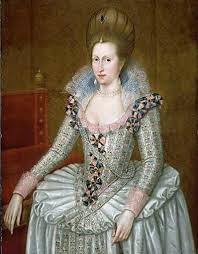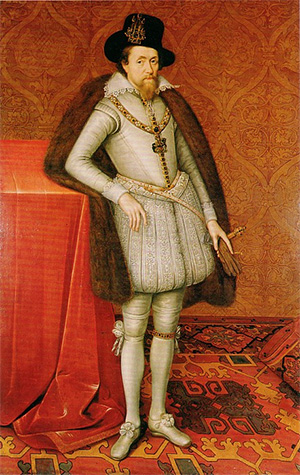Penelope Devereux: Life Story
Chapter 6 : Court Favourite (1603 - 1605)
The covert correspondence with James VI of Scotland at last paid off. When Elizabeth finally died on 24th March, 1603, Penelope was chosen by the new king to travel to Berwick to accompany his wife, Anne of Denmark, south to her new kingdom. Penelope was some eleven years older than the new Queen, but they formed a very warm relationship and she was appointed as one the Queen’s most senior attendants. In a sign that the Devereux were now back in favour, James permitted the late Earl’s three children to be restored in blood, and receive their father’s estates.

Penelope was so high in favour with both King and Queen, that, on 17th August 1603, at a ceremony at Farnham Castle, she was given the rank of the Earldom of Essex, in the seniority it had had under the Bourchier earls. This elevation gave her rank above all the baronesses, and most of the Earls’ daughters. Penelope’s great-great grandmother, Cecily Bourchier, had been the grand-daughter of the 1st Earl of Essex.
Over the next three years, Penelope became one of the leading lights in the Stuart court, taking part in the elaborate masques and entertainments that Queen Anne patronised. (Read more here)
Mountjoy, having brought the Irish war to a successful conclusion (from the English perspective), returned to London in 1603, and received the title of Earl of Devonshire from James I as well as being appointed as a Privy Councillor. He and Penelope now lived together openly.
In 1605, Lord Rich sought a divorce from the Church Commissioners. Whether he chose to instigate proceedings, because the open co-habitation of Penelope and Mountjoy was a step too far, or whether Penelope requested the divorce, which is the contention of her biographer, Sally Varlow, is unknown.
The divorce was granted on 14th November 1605, on the grounds of Lady Rich’s adultery with a man whom she refused to name in court. Archbishop Bancroft, pronouncing the sentence even went so far as to condemn Lord Rich for his hardness to his wife, and made derogatory remarks about Rich’s Puritan leanings.
As the marriage had been legal, and produced off-spring, the divorce was ‘from bed and board’, rather than an annulment, which would have required an Act of Parliament. The Church of England did not permit remarriage during the life-time of the other partner (a position that remained unchanged until 2002) and both Penelope and Lord Rich were ordered to live celibate lives.
Penelope and Devonshire immediately flouted the Church’s rules and went through a marriage ceremony conducted by Devonshire’s chaplain, William Laud, (later Archbishop of Canterbury) on 26th December 1605. This action called down a storm of anger and retribution on their heads.

King James, angered that they had defied the law, banished Penelope from court, telling Devonshire he had won
‘a fair woman with a black soul.’
Devonshire now wrote to James, explaining why he believed the marriage to be legal. One of his arguments was that Penelope had not freely consented to her marriage to Rich. Free consent was a fundamental requirement for valid matrimony. James remained unconvinced and Penelope remained banished.
In the Spring of 1606, Devonshire, as a Privy Councillor, was obliged to attend the trials of the Gunpowder Plotters, many of whom were members of Penelope’s extended family. In particular, her sister’s husband, the Earl of Northumberland, was a prime suspect, despite all of the other plotters denying he was involved. At the end of March, Devonshire failed to make an appearance at the trial of the Jesuit, Father Garnet. His health had been ruined by his campaigning, and he had been taken ill at Wanstead.
Penelope, pregnant again, raced to join him, and he spent his last days trying to protect the inheritance of their children. He died on 3rd April 1607, aged forty-three, with Penelope at his side. The shock and grief caused Penelope to miscarry.
Devonshire’s record of service in Ireland was not forgotten, and he was given a ceremonious funeral at Westminster Abbey, followed to his grave by the Earl of Southampton (who had narrowly escaped execution with Essex), Suffolk and Nottingham. In a clear sign that his marriage to Penelope was not recognised, her arms were not shown quartered with his, as was customary for a wife.
Prior to their marriage, Devonshire, had created complex legal and financial arrangements that would enable his children by Penelope to inherit his estates. The desire for a legal heir, which was so central to sixteenth century thought, may well have been a motivating factor in their speedy marriage.
As Devonshire had anticipated, his Will and property settlements were hotly contested. Various members of the Blount family, who saw an opportunity for taking control of Devonshire’s vast estate, suggested that he had been unduly influenced; that he was not of sound mind; and that he regretted his relationship with Penelope.
Probate was granted in the Canterbury Court, then appealed, then confirmed again. Eventually, a charge of fraud was brought against Penelope in the Star Chamber (the Privy Council and senior judges in session). She was described as
‘an harlot, adulteress, concubine and whore’.
Before the matter was settled, Penelope died on 6th July 1607. The location is unknown, but it was probably Essex House. Conflicting stories circulated – one that she had regretted her liaison with Devonshire, and wished to be reconciled to Lord Rich, dying firmly in the Protestant religion she had been brought up in. Father Gerard, however, claimed that, at the last, she converted to the Catholic faith.
Conclusion
Penelope was later described by Archbishop Laud as
‘A lady in whom lodged all attractive graces of beauty, wit and sweetness of behaviour’
and it is very apparent that she was able to charm both men and women, being beloved by her family, friends and servants.
Nevertheless, it is hard to escape from the conclusion that she was also rash and spoilt, unable to perceive that there might be other priorities than the advancement of her family, or the indulgence of her desires.
This article is part of a Profile on Lady Penelope Devereux available for Kindle, for purchase from Amazon.
Lady Penelope Devereux
Family Tree






